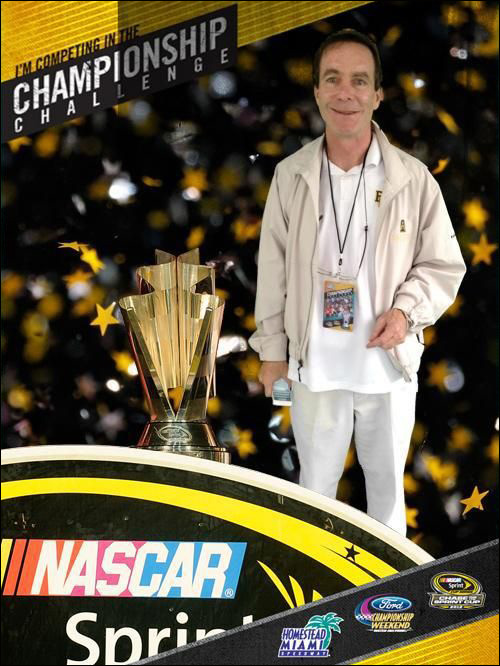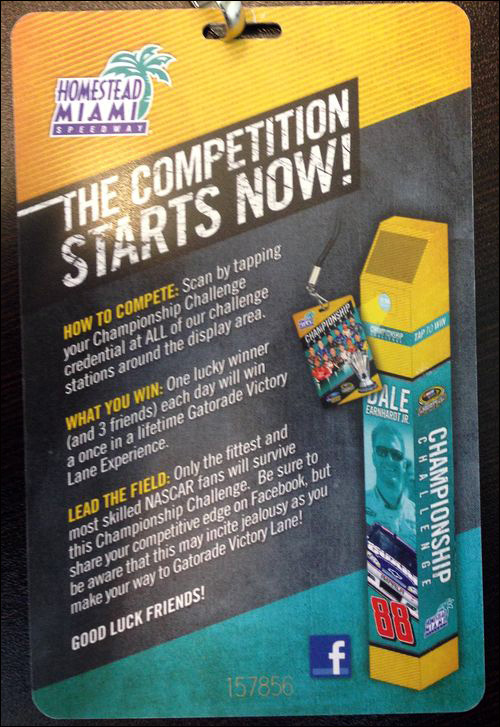To what extent does fans’ passion at a sporting or entertainment event affect their engagement with sponsors? And how can the attention of those fans be further directed toward the sponsors? Those are the questions that Kirk Wakefield, a professor at Baylor University’s Hankamer School of Business, intends to answer using radio frequency identification technology. To that end, at a NASCAR event held earlier this month at Homestead-Miami Speedway, in Homestead, Fla., Fish Technologies deployed a dozen RFID-enabled kiosks, and distributed RFID cards on lanyards to fans.
A group of Baylor researchers have begun sending questionnaires to the system’s users, in order to gauge their interest in the sponsors. The team also sought to determine whether that interest was increased by their participation in something like an RFID-enabled sweepstakes that brought them within a few feet of promotional displays set up by those sponsors. Fish Technologies provided the RFID-enabled cards and the kiosks, which employed the company’s own software and RFID readers. International Speedway Corp., which operates Homestead-Miami Speedway, provided an Internet connection, as well as the furnishings necessary for the registration stations.

Wakefield selected a three-day NASCAR race as the site for the study, which was funded by a grant from the Wharton School’s Customer Analytics Initiative, but he seeks not only to measure NASCAR fans’ interest in particular sponsors, but also to compare that interest level with those of fans of other sports or events. To accomplish this goal, Wakefield hopes to work with Fish Technologies in the future to install RFID systems at other sites.
During the three-day NASCAR event, attendees were offered RFID-enabled cards, and the opportunity to have their names entered in a drawing for VIP status at future races by visiting each of 12 RFID-enabled kiosks, known as “Tap Towers.” Following the event, Wakefield then sent a questionnaire to each participant, asking about the promotional information or activity, such as games and music provided by the race’s sponsors, which included Ford Motor Co. and the U.S. Army.Altogether, approximately 3,000 participants utilized the RFID cards to create a record of visits to the kiosks, as well as to post pictures of themselves on Facebook, says Rick Weldon, Fish Technologies’ president.
The “fan engagement” program was intended to challenge participants, by serving as a scavenger hunt. Fans had to visit all 12 widely dispersed readers and tap their 13.56 MHz passive high-frequency (HF) “RFID credential” (produced by Precision Dynamics Corp.) against each reader, in order to acknowledge that they had done so. Each tower (kiosk) was branded with the name of a famous NASCAR driver, and was located within a few feet of a sponsor’s promotional display.
Upon first arriving at the raceway, each fan was invited to participate in the Championship Challenge, by taking an RFID-enabled card and activating it by providing his or her name and contact information, as well as login information for Facebook, if that person so chose. Those with Facebook accounts could then have their photographs taken at a green screen providing a backdrop of their favorite NASCAR driver. Tapping the credential against a Fish Technologies reader attached to a staff member’s Apple iPad would result in a visitor’s picture being posted to his or her Facebook wall. If multiple people posed in the picture, the photo appeared on all of their individual Facebook pages.
The participants then began searching for RFID kiosks and tapping their RFID credential at each location. The reader captured each person’s tag ID number, and displayed how many kiosks remained for that individual to visit in order to be entered in the sweepstakes.One winner was chosen for each day of the three-day event. Attendees are now receiving questionnaires via e-mail, asking them about the sponsors that had set up the promotional displays.
The use of the sweepstakes drew visitors to locations where they were at least in visual contact with the sponsors, while the RFID technology tracked and confirmed that they were indeed at that location. By utilizing RFID, the researchers hope to learn the extent to which sponsors’ presence attract fan interest, as well as whether the technology’s use might increase that interest level by bringing fans into close contact with the sponsors.
According to Wakefield, future tests at NASCAR, or at similar events, will allow comparisons to be made regarding attendee interest in promotions at a variety of events, and could include various methods of engaging participants. For example, a Tap Tower might be configured to enable users to take a picture promoting a particular product, or to display details about that product, each time that an individual’s RFID tag is read.
Immediately after the event, Weldon says, the system worked well. “The reception by fans was great,” he states. “There were lines at the Tap Towers.”


